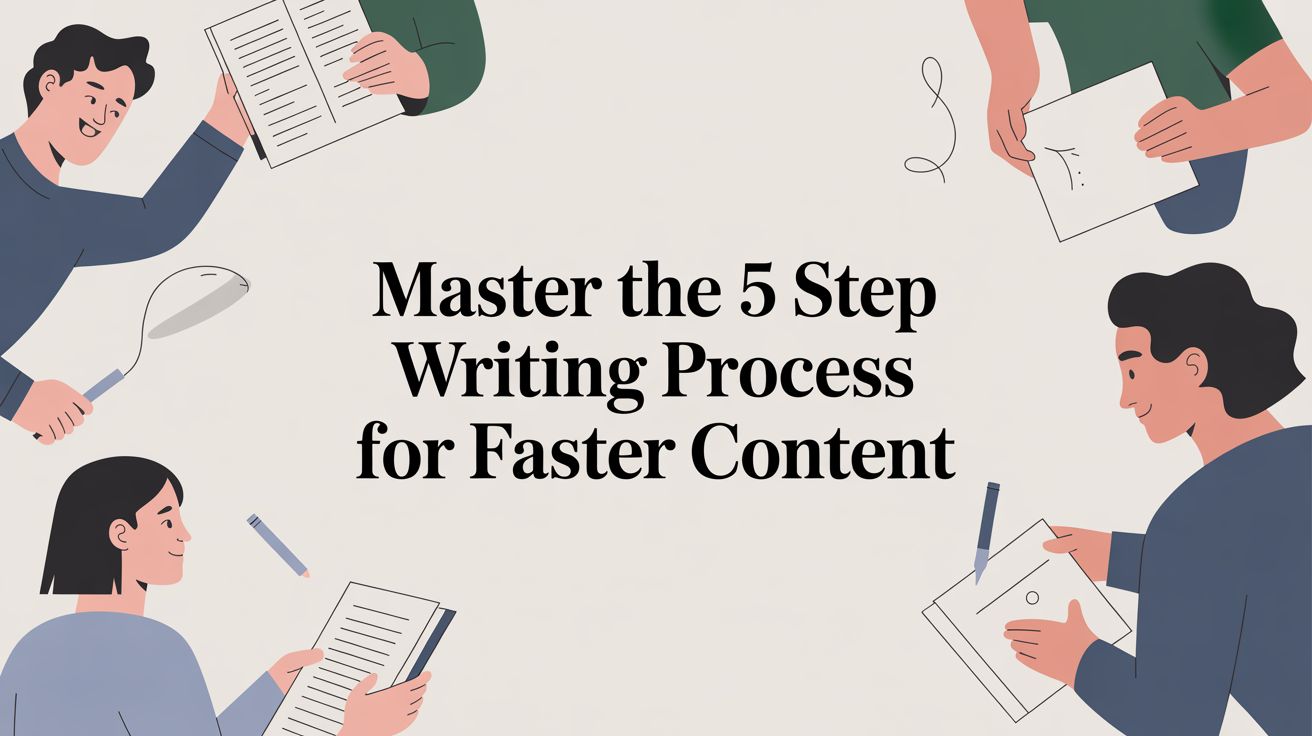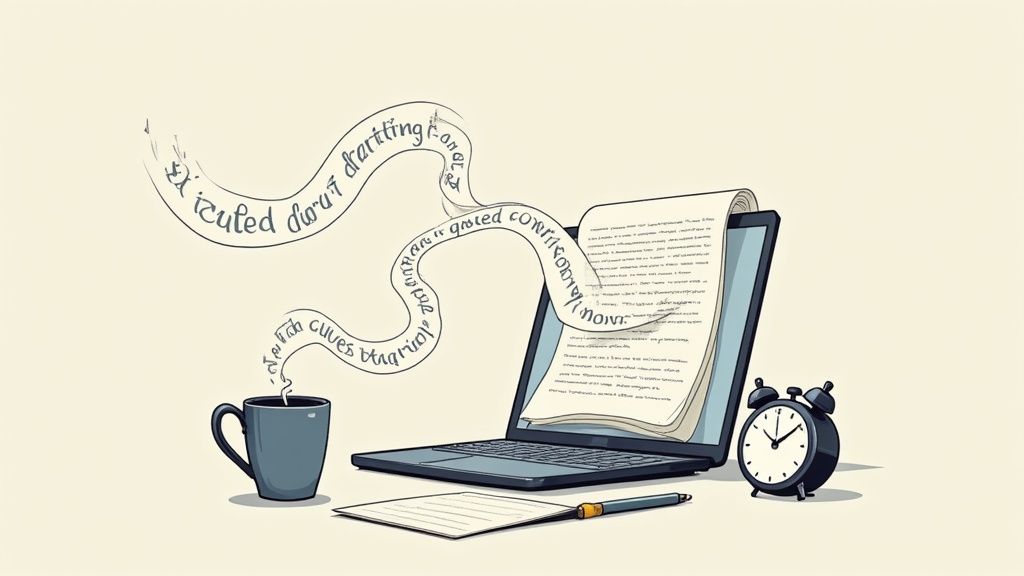Master the 5 step writing process for faster content

For solo founders and small teams, time isn't just money-it's your entire runway. Every hour spent wrestling with writer's block, messy drafts, or endless revisions is an hour not spent on sales, product, or customer support. The myth of the 'perfect writer' who waits for inspiration is a luxury startups can't afford. What you need isn't more time; it's a repeatable system that turns ideas into polished, revenue-driving content with ruthless efficiency.
This guide breaks down the definitive 5 step writing process, re-engineered for operators who need to ship faster without sacrificing quality. We'll move beyond generic advice and give you actionable checklists, time-saving tools, and clear decision cues for when to iterate and when to hit publish. Forget the blank page anxiety; it's time to install a writing OS that works as hard as you do.
You will learn a structured approach that covers everything from initial brainstorming and planning to the final stages of publishing and distribution. Each step is designed to be a self-contained module with specific goals, helping you eliminate guesswork and produce consistent, high-impact content for your blog, website, or marketing campaigns. We’ll show you how to manage your workflow using tools like Notion for planning and QuillBot for refining your prose. As a resource hub, Unkoa Marketing focuses on creating these exact systems to help you scale your efforts efficiently, ensuring your writing becomes a predictable asset rather than a bottleneck.
1. Step 1: The 60-Minute Prewriting Sprint (Planning & Research)
For a busy founder or a lean marketing team, the most valuable currency is time. The biggest time-waster in content creation isn't writing itself; it's the endless, painful process of revising a directionless draft. The 60-Minute Prewriting Sprint is your defense against this common pitfall. It's a compressed, high-leverage planning session that turns a vague idea into an actionable blueprint.
This isn't about aimless brainstorming. It's a strategic framework designed to ensure every piece of content you produce is sharp, targeted, and serves a specific business objective. By front-loading the strategic thinking, you make the actual writing process faster, easier, and exponentially more effective. This is a core component of a functional 5 step writing process because it builds the foundation upon which everything else rests.
Why This Prewriting Sprint Matters for Founders
Skipping the planning stage is like setting out on a road trip without a map. You'll eventually get somewhere, but it will be an inefficient, frustrating journey, and you likely won't end up at your intended destination. For founders, this translates to content that is:
- Rambling and unfocused: It tries to cover too much ground and fails to deliver a single, powerful message.
- Misaligned with business goals: It generates vanity metrics (likes, shares) but fails to drive meaningful actions like demo requests or email sign-ups.
- Time-intensive to edit: A poorly planned draft requires structural overhauls, not just minor tweaks, consuming hours that could be spent on product or sales.
A solid prewriting sprint ensures your content is purpose-built from the very beginning.
The 60-Minute Prewriting Sprint: A Practical Playbook
Here’s how to structure your hour for maximum impact. Set a timer and work through these tasks methodically.
- Define Your North Star (10 minutes): First, answer two critical questions. Who are you writing for? Be specific beyond "our customers." Think about their job title, their primary pain point, and what they need to believe to take the next step. What is the single most important action you want them to take after reading? This clarity is non-negotiable.
- Keyword and SERP Analysis (20 minutes): Identify your primary keyword and 2-3 related secondary keywords. Use a tool like Frase to analyze the top-ranking articles for that keyword. Don't just look at their headings; identify patterns in the topics they cover, the questions they answer, and the formats they use. This isn't about copying; it's about understanding the existing conversation so you can add a unique, valuable perspective.
- Gather Your Evidence (15 minutes): Find 3-5 compelling statistics, expert quotes, or internal data points that support your main argument. These will serve as the pillars of your article, adding credibility and substance. Having these ready beforehand prevents you from pausing your writing flow to search for sources later.
- Bookend Your Article (15 minutes): Write a "shitty first draft" of your introduction and conclusion. The introduction should hook the reader by stating the problem and promising a solution. The conclusion should summarize the key takeaway and drive them toward your desired call-to-action. Getting these down first creates a clear beginning and end, making it much easier to fill in the middle.
Key Insight: The goal of this sprint isn't a perfect outline. It's a complete content brief. You should end the hour with a document that another writer could use to produce a high-quality draft that aligns perfectly with your goals.
Prewriting Checklist & Template
To streamline this process, create a reusable template in a tool like Notion or Todoist. Your template should include:
- [ ] Target Audience: (e.g., Early-stage SaaS founders struggling with lead generation)
- [ ] Primary Goal: (e.g., Drive sign-ups for our "Content Marketing for Founders" webinar)
- [ ] Primary Keyword: (e.g., "saas content marketing strategy")
- [ ] Secondary Keywords: (e.g., "b2b saas content," "founder content strategy")
- [ ] SERP-Informed Outline: (Bulleted list of H2s and H3s based on research)
- [ ] Core Statistics/Data: (List of 3-5 sourced facts)
- [ ] Draft Introduction: (2-3 sentences hooking the reader)
- [ ] Draft Conclusion & CTA: (2-3 sentences summarizing and directing the reader)
Decision Cue: When to Iterate
Before moving to the drafting stage, gut-check your plan with this simple test: Can you articulate the article's core message in a single, compelling sentence? If you stumble or the sentence is convoluted, your core idea isn't sharp enough. Loop back and refine your audience, goal, or angle until you have a crystal-clear thesis. This small check saves hours of revision down the line.
2. Step 2: The Focused Flow Draft (Composing)
With a solid blueprint from your prewriting sprint, the next hurdle is translating that plan into prose. This is where many founders get stuck, paralyzed by the quest for the perfect sentence. The Focused Flow Draft is your antidote to perfectionism. It’s a dedicated, time-boxed session where the only goal is to get words on the page, transforming your outline into a complete, albeit rough, narrative.
This stage is about momentum, not mastery. Popularized by authors like Anne Lamott with her concept of "shitty first drafts," this approach separates the creative act of writing from the analytical act of editing. By silencing your inner critic and focusing purely on getting your ideas down, you build the raw material needed for a polished final product. This is a critical part of any effective 5 step writing process because it turns a plan into a tangible asset.

Why This Drafting Method Matters for Founders
Staring at a blank page is intimidating. Trying to write and edit simultaneously is a recipe for burnout and slow progress. For a founder, this leads to content bottlenecks where valuable ideas never see the light of day. A focused drafting process eliminates this by:
- Maximizing creative energy: It allows you to stay in a state of creative flow, preventing the constant context-switching between writing and editing that drains mental resources.
- Accelerating content velocity: It dramatically speeds up the time it takes to get from idea to a full draft, allowing you to produce more content in less time.
- Reducing the fear of the blank page: With a clear outline and the freedom to be imperfect, starting is no longer the hardest part. The pressure is off.
The Focused Flow Draft ensures you have a complete article to work with, making the subsequent editing phase a more structured and less daunting task.
The Focused Flow Draft: A Practical Playbook
Here’s how to structure your drafting session for maximum output. The goal is imperfect completion.
- Set the Stage (5 minutes): Open your prewriting brief. Reread your North Star (audience and goal), your outline, and your draft introduction/conclusion. This re-centers your focus on the core message and structure you've already defined. Close all other tabs and turn off notifications.
- Write in Timed Sprints (45-60 minutes): Use the Pomodoro Technique. Set a timer for 25 minutes and write without stopping. Don't look back, don't fix typos, and don't rephrase sentences. If you get stuck on a section or need a statistic you forgot to find, type "[TK-STAT HERE]" or "[REPHRASE THIS]" and keep moving. Your only job is to fill the space between your intro and conclusion based on your outline. Take a 5-minute break and repeat.
- Use Your Outline as Guardrails: Follow the H2s and H3s from your prewriting sprint. Write one section at a time. This breaks the article into manageable chunks and ensures you stay on track, covering all the key points identified during your research.
- Embrace Voice-to-Text (Optional): If you find typing slow or unnatural, use a voice-to-text tool like the one built into Google Docs or your operating system. Speaking your draft can often feel more natural and bypass the mental filters that cause writer's block.
Key Insight: You cannot edit a blank page. The primary objective of the drafting stage is to create something, anything, to edit. A messy, complete draft is infinitely more valuable than a few perfect, disconnected paragraphs.
Drafting Checklist & Template
Integrate this into your content template in a tool like Notion or Todoist to keep your process consistent.
- [ ] Prewriting brief is open and reviewed.
- [ ] All distractions (email, social media) are closed.
- [ ] Timer is set for a 25-minute sprint.
- [ ] Goal: Write without self-editing, following the outline.
- [ ] Placeholders used for missing info (e.g., [TK-DATA]).
- [ ] Draft is complete from introduction to conclusion.
- [ ] AI-assisted drafting tools like Frase can help you move from an outline to a rough draft even faster.
Decision Cue: When to Stop
The drafting phase is complete when you have a full, end-to-end version of your article. It will be rough, contain typos, and have awkward phrasing. That’s the sign of success. The key test is: Does the draft address every point in your outline? If yes, you are ready to move on. Resist the powerful urge to start editing immediately. Step away for at least a few hours, or ideally a full day, to gain fresh perspective before entering the revision stage.
3. Step 3: The Architect's Revision (Content & Organization)
For founders and marketers, the first draft is just raw material. The real value is forged in the revision stage. This isn't about fixing typos or polishing sentences; that comes later. Revision is the architectural overhaul, where you transform a collection of ideas into a cohesive, persuasive, and powerful argument. It’s where you ensure the structure is sound and the content delivers on its promise.
Many writers mistakenly merge revision with editing, but they are fundamentally different tasks. Revision is macro-level, focusing on the big picture: argument, clarity, structure, and support. It's the most critical part of this 5 step writing process for turning a mediocre draft into a piece of content that actually drives business results. It requires you to step back, see your work from the reader's perspective, and be ruthless in making improvements.
Why This Revision Matters for Founders
A first draft is often a "writer-centric" document; it’s you figuring out what you want to say. Revision transforms it into a "reader-centric" asset. Skipping this step means publishing content that is:
- Logically confusing: The argument jumps around, making it difficult for a busy prospect to follow and diminishing your credibility.
- Structurally weak: Important points are buried, while minor details get too much attention, causing readers to lose interest and bounce.
- Lacks impact: The core message is diluted by redundant paragraphs, weak evidence, or an unclear thesis, failing to persuade the reader to take action.
A dedicated revision phase ensures your final piece is not just written, but engineered to guide your ideal customer from a state of uncertainty to a state of conviction.
The Architect's Revision: A Practical Playbook
Set aside a focused block of time, ideally a day or two after finishing your draft to gain perspective. Then, work through these passes methodically.
- The "Big Idea" Pass (15 minutes): Read your draft from start to finish without making any changes. The only goal is to answer one question: Does this article deliver on the promise made in the introduction? Identify your core thesis and check if every section directly supports it. If a paragraph or section deviates, it either needs to be cut or reframed.
- The Reverse Outline Pass (25 minutes): Open a new document. For each paragraph in your draft, write a single sentence that summarizes its main point. Now, look only at your new outline of summary sentences. Does the logic flow? Are there gaps? Are points in a strange order? This technique instantly reveals structural weaknesses that are hard to spot when you're immersed in the full text.
- The Evidence Strength Pass (10 minutes): Scrutinize the data, quotes, and examples you used. Is this the strongest possible evidence to support your claims? Is it credible and clearly sourced? Weak evidence undermines your entire argument. Be prepared to swap out statistics or examples for more compelling ones.
- The "So What?" Pass (10 minutes): Read each key point and ask yourself, "So what?" Why does this matter to my target audience? If the answer isn't immediately obvious, you need to add context or a sentence that explicitly connects the point to your reader's pain points or goals. This ensures every part of your article provides tangible value.
Key Insight: The purpose of revision isn't to perfect your writing; it's to perfect your argument. A powerful, well-structured argument will resonate with readers far more than perfectly polished but weak ideas.
Revision Checklist & Template
Add this checklist to your content template in a tool like Notion or Todoist to guide your revision process for every article.
- [ ] Thesis Check: Is the main argument clear, concise, and stated early?
- [ ] Logical Flow: Does the reverse outline show a logical progression from one point to the next?
- [ ] Paragraph Unity: Does each paragraph focus on a single, clear idea?
- [ ] Supporting Evidence: Is every claim backed by strong, credible evidence?
- [ ] Redundancy Check: Have I removed repetitive sentences or paragraphs?
- [ ] Reader Value: Does every section answer the "So what?" question for the reader?
- [ ] Introduction-Conclusion Alignment: Does the conclusion effectively summarize the argument promised in the intro and drive to the CTA?
Decision Cue: When to Get Feedback
Before moving to the editing stage, use this test: Have you rearranged or deleted at least one major paragraph or section? If your answer is no, you have likely been editing, not revising. True revision almost always involves significant structural changes. If you've made these big changes and feel the structure is sound, now is the perfect time to get a second opinion from a trusted colleague or a peer reviewer before you start fine-tuning the language.
4. Step 4: The Surgical Edit (Style, Grammar & Language)
After revising the big-picture structure, it’s time to zoom in. The surgical edit is where you trade your architect’s hat for a jeweler's loupe. This stage is less about what you’re saying and more about how you’re saying it. It’s the technical, detail-oriented pass that transforms a solid draft into a polished, professional piece of content.
This isn’t a quick spell-check. It's a meticulous process of refining language at the sentence and word level to ensure clarity, correctness, and consistency. For a founder, this step is what builds trust. Clean, error-free copy signals attention to detail and professionalism, while sloppy writing can subtly erode a reader's confidence in your brand. This phase of the 5 step writing process ensures your message is delivered without the distraction of technical errors.
Why The Surgical Edit Matters for Founders
If revision is about fixing a broken engine, editing is about detailing the car. A powerful message can be completely undermined by poor grammar, awkward phrasing, and simple typos. For founders and their brands, this can lead to:
- Damaged Credibility: Simple mistakes can make your company appear careless or unprofessional, creating a barrier to trust before a prospect ever speaks to your sales team.
- Reader Confusion: Unclear sentences and poor word choice force the reader to work harder to understand your point, increasing the chance they'll just give up and leave.
- Inconsistent Brand Voice: Without a deliberate editing pass, your content can sound different from piece to piece, diluting your brand identity and making it harder to build a memorable presence.
A dedicated editing phase ensures your final output is as sharp and professional as the product or service you sell.
The Surgical Edit: A Practical Playbook
The key to effective editing is to separate it from writing and revision. Your brain uses different muscles for creating ideas versus finding flaws. Give yourself at least a few hours (or a day) between Step 3 and Step 4. Then, tackle it with this focused approach.
- The Mechanical Pass (Automated): Run your draft through a dedicated editing tool first. Tools like Grammarly or QuillBot are excellent for catching the low-hanging fruit: spelling errors, punctuation mistakes, and basic grammatical slip-ups. This cleans the slate so you can focus on more nuanced issues.
- The Read-Aloud Pass (Auditory): Read your entire article out loud. This is the single best way to catch awkward phrasing, clunky sentences, and unnatural rhythm. If you stumble over a sentence while saying it, your reader will stumble while reading it. Mark these spots for immediate rewriting.
- The One-Thing-at-a-Time Pass (Focused): Don't try to fix everything at once. Do multiple, quick passes, each with a single goal. First, scan only for consistency (e.g., did you write "e-book," "ebook," or "eBook"?). Next, scan just for overused words or jargon. Then, scan for sentence length variation. This compartmentalized approach is far more effective than trying to catch every type of error simultaneously.
- The Backwards Pass (Typo Hunt): To isolate spelling and word errors from their context, read your text backward, one sentence at a time. This forces your brain to look at each word individually rather than skimming over familiar phrases, making it surprisingly effective for catching typos you've read a dozen times.
Key Insight: Great editing is invisible. Its goal is to remove every point of friction between your message and your reader, creating a smooth, effortless reading experience that lets your ideas shine.
Editing Checklist & Template
Add this checklist to your content template in Notion or your project management tool to ensure a consistent, high-quality finish for every article.
- [ ] Automated Check: Ran through Grammarly/QuillBot and accepted/rejected all suggestions.
- [ ] Read-Aloud Check: Read the entire text out loud and smoothed out all awkward sentences.
- [ ] Brand Voice Check: Does the tone align with our company’s style guide? (e.g., formal, conversational, witty).
- [ ] Consistency Check: All terms, capitalization, and formatting are consistent throughout the document.
- [ ] Clarity Check: Removed jargon, simplified complex sentences, and eliminated vague words.
- [ ] Final Proofread: Performed one final, slow read-through to catch any remaining errors.
Decision Cue: When to Hire Out
As a founder, your time is your most limited resource. If you find yourself spending more than 45-60 minutes editing a standard blog post, it's a strong signal to outsource. Is this editing task a high-leverage use of a founder’s time? For most, the answer is no. A professional editor from a platform like Fiverr can do a better job in a fraction of the time, freeing you to focus on strategy, sales, or product development. The small investment pays for itself in time saved and increased content quality.
5. Publishing/Sharing (Final Review & Distribution)
Your content doesn't exist until someone reads it. The final, and arguably most critical, stage of the writing process is moving your polished draft from a private document to a public asset. Publishing isn't just clicking a button; it's the strategic launch of your hard work, encompassing final quality checks, on-page optimization, and a distribution plan that ensures it reaches your target audience.

For busy founders, this step is where content shifts from a cost center to a revenue driver. A brilliant article hidden on page ten of Google or lost in a social media feed generates zero ROI. This final component of the 5 step writing process ensures your investment in creation pays dividends through visibility, engagement, and conversion.
Why Publishing and Distribution Matter for Founders
Treating "publish" as the finish line is a common and costly mistake. Without a deliberate distribution strategy, even the best content fails. For founders, a weak publishing process leads to:
- Content Invisibility: Your article doesn't rank on search engines and gets no social traction, effectively making the time you spent writing it worthless.
- Wasted Opportunities: A single blog post can be a pillar asset, but only if it's promoted. Failing to share it across relevant channels means leaving potential leads and traffic on the table.
- Poor User Experience: Technical glitches like broken links, poorly formatted text, or slow-loading images can frustrate a potential customer and damage your brand's credibility right before the conversion.
A thoughtful publishing and distribution phase maximizes the reach and impact of every single piece of content you create.
A Practical Playbook for Publishing and Distribution
Here’s how to structure your final push for maximum visibility and engagement.
- The Final Quality Assurance (QA) Check (15 minutes): Before your content goes live, run through a final pre-flight checklist. Read the piece one last time on the platform where it will be published (e.g., the blog preview). Check for formatting errors, ensure all internal and external links work, and verify that all images load correctly and have descriptive alt text. This is your last chance to catch small errors that can make a big difference.
- On-Page SEO Optimization (15 minutes): Ensure your content is set up to succeed on search engines. Confirm your primary keyword is in the URL, title tag, meta description, and the first paragraph. Optimize your H1 and H2 headings. This small time investment significantly increases your content's long-term organic reach.
- Schedule and Promote (20 minutes): Don't just publish; launch. Schedule your post for a time when your audience is most active. Prepare 3-5 social media posts for different platforms (LinkedIn, Twitter, etc.) to promote the article. Draft an email to send to your newsletter subscribers announcing the new content.
- Engage and Monitor (10 minutes): Once the article is live, the work isn't over. For the first few hours, monitor social media for comments and questions. Engaging with early readers can boost your content's visibility and show that you value your audience's input.
Key Insight: Think of your content as a product launch. You wouldn't launch a new feature without a marketing plan. Apply the same discipline to your content by creating a simple, repeatable distribution plan for every piece you publish.
Publishing Checklist & Template
Use a task management tool like Todoist to create a reusable publishing checklist for your team.
- [ ] Final Proofread: (Grammar and spelling check complete)
- [ ] Formatting Check: (Previewed on-site, headings, lists, and images look correct)
- [ ] Link Verification: (All internal and external links have been clicked and verified)
- [ ] On-Page SEO: (Title tag, meta description, URL, and alt text are optimized)
- [ ] Social Posts Drafted: (Posts for LinkedIn, Twitter, etc. are written and ready)
- [ ] Newsletter Copy Written: (Email announcement is drafted)
- [ ] Post Published/Scheduled: (Content is live or scheduled for optimal time)
- [ ] Promotion Channels Activated: (Social posts and email have been sent)
Decision Cue: When to Iterate
After your content has been live for a week, check its initial performance. Is a specific social media channel driving the majority of your traffic? If you notice that a LinkedIn post drove 80% of your views while Twitter drove none, it's a clear signal. For your next article, double down on the high-performing channel and spend less time on the one that didn't deliver. This iterative approach refines your distribution strategy over time, maximizing your results. You can also explore options to learn more about how to repurpose a podcast into a blog post for solo founders on Unkoa.com.
5-Step Writing Process Comparison
| Stage | Implementation complexity | Resource requirements | Expected outcomes | Ideal use cases | Key advantages |
|---|---|---|---|---|---|
| Prewriting (Brainstorming & Planning) | Low–Moderate — structured thinking and research | Moderate time; research sources, brainstorming tools, outlines | Clear purpose, thesis, and roadmap; fewer major revisions | Research papers, content strategy, story outlining | Reduces writer's block; improves organization and focus |
| Drafting (First Draft/Composing) | Low — emphasis on speed and flow, not polish | Time for focused writing sprints; distraction-free space | Substantial raw content; developed ideas and narrative arc | Novels, article first-pass, NaNoWriMo, rapid content production | Generates material quickly; lowers perfectionism |
| Revising (Content & Organization) | High — structural reworking and argument refinement | Significant time; peer feedback; possible additional research | Coherent structure; stronger arguments; trimmed redundancies | Manuscript overhauls, academic revisions, campaign restructuring | Strengthens logic and clarity; fixes major conceptual issues |
| Editing (Style, Grammar & Language) | Moderate — detail-oriented sentence- and word-level work | Style guides, editing tools, careful line-by-line review | Polished language, consistent style, corrected mechanics | Publication prep, academic submissions, brand collateral | Improves readability and credibility; enforces consistency |
| Publishing/Sharing (Final Review & Distribution) | Moderate — formatting plus distribution logistics | Formatting/design tools, platform selection, promotion resources | Final formatted output live to audience; feedback and reach | Books, blogs, journals, social media, internal distribution | Delivers work to audience; enables engagement and measurable impact |
Install This System and Make Content Your Growth Engine
Navigating the content landscape without a map is a recipe for wasted hours and inconsistent results. What we've outlined here is more than just a series of tips; it's a complete operational system. The 5 step writing process provides a reliable framework that transforms content creation from a chaotic art form into a predictable manufacturing line for growth.
By dedicating specific blocks of time to prewriting, drafting, revising, editing, and publishing, you introduce discipline and focus into your workflow. This systematic approach is the secret to scaling your output without sacrificing quality, a non-negotiable for solo founders and lean teams where every minute counts. You stop being a "content creator" who waits for inspiration and become a strategic operator who builds assets.
From Process to Performance: Key Takeaways
Mastering this framework means you're no longer just publishing articles; you're engineering outcomes. Let’s distill the core value of this system into its most critical takeaways:
- Clarity Comes from Structure: The prewriting phase is your most leveraged activity. A detailed plan and outline built here prevent the dreaded blank page paralysis and ensure your first draft has a clear purpose and direction from the very first word.
- Momentum is Your Ally: Separating drafting from editing is the ultimate productivity hack. Giving yourself permission to write a messy first draft keeps your momentum high and your inner critic silent, allowing you to get your core ideas down quickly and efficiently.
- Quality is Built in Layers: True quality isn't achieved in a single, heroic effort. It’s built methodically. The revision stage sharpens your arguments and structure, while the distinct editing stage polishes your prose. Each step adds a new layer of value, resulting in a final product that is both substantive and professional.
- Publishing is Not the Finish Line: The final step isn't just about hitting "publish." It's about strategic distribution and repurposing. A single well-crafted article can be the source material for a dozen social media posts, a video script, or an email newsletter, maximizing the ROI on your initial time investment.
Your Action Plan: Making the 5 Step Writing Process Your Own
Knowledge without action is useless. To truly internalize this system and see its benefits, you need to implement it immediately. Start small, but start now.
Your next step is to take one content idea and walk it through this entire 5 step writing process. Don't just read about it; do it. Block out time on your calendar for each distinct stage. Use a tool like Notion or Todoist to create a project template based on the checklists provided.
The real power of this framework reveals itself through repetition. The first time may feel rigid, but by the third or fourth cycle, you'll notice a dramatic increase in your speed and a significant reduction in stress. You'll have built a system that consistently produces high-quality content, freeing you up to focus on the bigger picture: building relationships, engaging your audience, and driving measurable business growth. This process is your engine. Now, it's time to turn the key.





